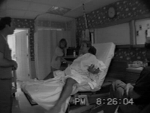Part II.1 -- What is not at stake
In the preceding section, we showed how the major properties of Hospital Labor retreat into the taken for granted world of Contractions and Medical Visits as participants inscribe on top of this world an extraordinary world of special or local identifications (e.g. "Lonnie is dangerous!") that remain open to further negotiations. In the case of Lonnie's telling of her pain, what is put to play is not a minor matter since her success at negotiating extra anesthetics in her earlier labor arguably put the life of her child at risk. In the world of her intentionality, it may even be that her apparent surrender to the medical world is a recognition that she may put herself as significant danger though clearly in a way that is made possible by the medical world itself: One cannot talk oneself into "too much anesthetics" in a world without anesthetics. Her intentionality may thus place her in danger given a particular world, but it cannot make this world.A woman, a child, a hospital, pain. What is at stake is thus well marked though the method of markedness is itself a complex matter: there is what must remain taken for granted and there is what must be negotiated. Lack of marking as somehow at stake is not to be taken however as absence. Much emerged during the course of this labor that was not cross-referenced as relevant to the labor. The demographics about Lonnie and the anesthesiologist (number of children, age, wife's age, future plans) are made available but they do not appear to make any discernible difference in the progression of the labor. None of the decisions that have to be made are specifically made because of this information (by contrast Lonnie's height, and possible lies about it, are relevant given that her height partially determines the epidural dosage). Given these preliminaries, we can now look at one of the moments when Lonnie's status as a medical doctor is actually brought out in the conversational open:
TRANSCRIPT V
 |
[Anesthesiologist enters the room, talks briefly to the nurse, and then turns towards the husband. He leans forward to shake husband's hand as he appears to introduce himself. The anesthesiologist then strenghtens up, crosses his hand in front of himself as he faces L. and directly addresses her. He keeps this stance until 827:10 while he, first, chats with her about her job, second, explains to her about the epidural procedure and, third, they negotiate how this epidural will take place] |
| (FULL TRANSCRIPT II: Seconds 825:50 to 827:14) |
The first part of this transcript establishes that Lonnie's exact status as "a doctor too" is available to all. This status may be somewhat devalued in the specification that she is an "internist" working administratively in an HMO, just like the anesthesiologist's "wife" does. But it is specifically invoked, and then not used as the anesthesiologist proceeds to explain the procedure without reference to the possible special knowledge Lonnie might have whether because of her education, or even because this will be the third time she has had an epidural during labor. Lonnie accepts the explanation and then the questions about allergies, and then initiate a negotiation about the position she will assume for the epidural: lying down or sitting up. She asks the question as a matter of fact, without marking the source of her knowledge about the possibilities of alternatives, not even indexically. The anesthesiologist yields to Lonnie by emphasizing her right to claim what would make her "feel more comfortable." There is no chitchat about possible medical issues relating to a body's position during an epidural. "Comfort," like pain, is an argument a patient may use. For all intent and purposes, by the end of the first part of the transcript, Lonnie is back to being a patient and her status as a doctor is never mentioned again by the anesthesiologist in his subsequent visits for example the long one discussed earlier (917:50).

